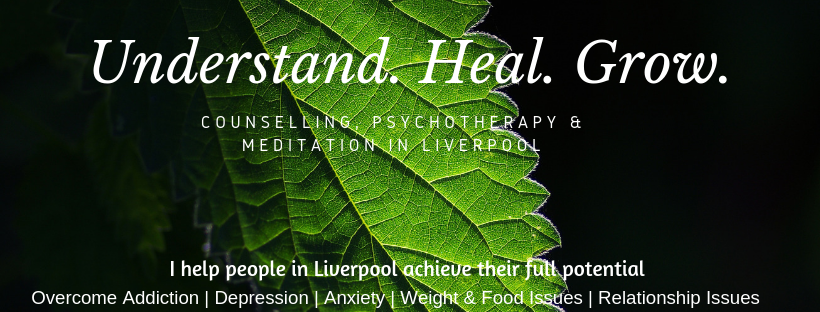I use ‘Understand, heal, grow’ as a tag line on my directories and advertising. In this blog I explain why, for me, it encapsulates the client journey through therapy and how I work as a therapist.

For me, it all starts with understanding.
Understanding is first and foremost about expanding our (self) awareness. Often we can feel so stuck and entangled in the challenges we are facing that we feel lost and confused.
Yet if we can’t see things clearly, how can we hope to begin to do anything meaningful about them?
In therapy, we can begin to express (sometimes for the first time) the tangled, complicated streams of thought and emotion that occupy our headspace. Just hearing ourselves say things out loud can in itself be a cathartic and illuminating experience. To do so in the context of a safe, warm, encouraging, accepting and genuine relationship with someone who is fully present, holding space for us and bearing witness to what we share can be truly transformative (healing).
There can be a sense for some clients of taking all of those confusing things out of their head and placing them in the room, out on the floor in the space between themselves and their therapist so that they can observe and explore them together in a safe space, without judgement. This allows a sense of observing or witnessing our own process and experience as human beings with a fresh perspective – a game changer in terms of true self-awareness.
“Awareness is like the sun. When it shines on things, they are transformed.” (Thich Nhat Hanh)
When we can step back from our entangled, reactive conditioning and see things more clearly, we can understand ourselves more fully with mindful awareness.
As Carl Rogers said, “once an experience is fully in awareness, fully accepted, then it can be coped with effectively, like any other clear reality“.
As well as holding space for my clients and bearing witness to their story, I adopt a stance of kind curiosity. I am curious about how my clients experience themselves and their world, from their frame of reference – how it feels to be them. I wish to understand them as fully as I can – just how they think, feel and act, and why they think, feel and act the way that they do. To this end, I inquire, question and reflect; sharing my own honest thoughts and feelings in the process as we work together to understand what is going on for them. This also models for clients how they might relate to their own inner world with a sense of kind curiosity, free from judgment or criticism.
From this place of greater clarity, self-curiosity and self-awareness, a deeper layer of understanding can take root: self-empathy and, ultimately self-compassion and self-acceptance. This is when healing begins.
Truly seeing and understanding ourselves – our process, the ways we react and relate to others and the reasons we behave the way we do can allow us to begin to take a gentler, kinder, more compassionate view of ourselves. Rather than criticise and condemn ourselves from the perspective of the inner critic, we might begin to see that the patterns and behaviours that we struggle with are almost always just our very human ways of coping with the complexity and suffering inherent in all of our lives.
As Freud says, “Life, as we find it, is too hard for us; it brings us too many pains, disappointments and impossible tasks. In order to bear it, we cannot dispense with palliative measures“
Whether our struggle is with alcohol, drugs or gambling, or perhaps our patterns in relationships or whatever it is that brings us to therapy, when we see that we are, in our own way, just trying to cope and ultimately survive, the inner critic can begin to lose its grip on us.

Beginning to relate to ourselves with greater understanding and compassion is at the heart of how we heal.
This healing comes about through the very process of awareness and understanding, the empathy and compassion that naturally flows from truly seeing and understanding ourselves as vulnerable, flawed-but-worthy human beings doing the best that we can to get by.
But where healing truly occurs, is in the context of the therapeutic relationship between client and therapist. Being met with kind curiosity in the context of a safe, warm, accepting, supportive, encouraging, understanding and genuine relationship not only allows the client to feel safe enough to open up and share, but this kind of relationship is, in itself, truly transformative. It is this way of being (as Rogers described it) that is the ultimate gift we therapists strive to offer to our clients. As Rogers noted, the core conditions of unconditional positive regard (acceptance or prizing), empathy (understanding) and congruence (genuineness / authenticity) allow us the conditions that we need as human beings to grow towards our full potential.
This kind of relationship can offer a secure base – a safe, caring, consistent and trustworthy relationship that can go some way to healing the attachment issues so many of us carry with us from our childhoods. Such a relationship can allow you the powerfully healing realisation that there is nothing fundamentally wrong with you. In fact, through experiencing yourself through the therapist’s eyes, you might begin to see that you are enough, that you are worthy, that you matter and that you deserve to be happy. Through being accepted, valued and understood by the therapist, perhaps you might begin to be able to accept, value and understand yourself. From this place, individuals begin to trust and value themselves more, to more fully feel and express their emotions and to live more fully in the moment. And, with their defenses lowered and self-awareness increased, clients find themselves more able to take responsibility for their own happiness and wellbeing and to see their own part in the co-creating the negative patterns in their lives. Personal responsibility is a prerequisite for healing and growth to occur. This is because it empowers us to change the things that we can change (our own choices and actions) and to accept or make peace with the things that we cannot change.
Therapy as a dress rehearsal for life. Whilst the therapeutic relationship is, in itself, powerfully healing, the relationship between client and therapist also provides the arena for a greater healing project. Working together collaboratively in an active, engaged way, my clients and I get stuck into the work of ‘removing the obstacles to growth‘ (as Irvin Yalom phrases it). We use the relationship between us itself as a place in which to experiment with how it might be to, for example, be more open, more vulnerable, more honest; to express our feelings, practice assertiveness and boundaries; work through conflict or ask for our needs to be met. In this way, the therapeutic relationship becomes a testing ground for changes a client might wish to make in their other relationships. This work allows significant healing to take place by offering a corrective emotional experience, for example, allowing you to experience that whilst being vulnerable can feel scary, exposing and even ‘cringey’, not only is it safe to be vulnerable with the right people, but it also feels empowering, authentic and invites relationships with others that are much deeper, more meaningful and more real.

The final stage of healing takes place as clients take their expanded self-awareness, understanding and their learning from the therapeutic relationship back into their intimate, familial and friendship relationships. Building deeper, more meaningful and satisfying relationships is the cornerstone of our wellbeing and happiness as human beings. If we as therapists can assist our clients in learning how to better relate to others and create the kind of connection that they crave, we will have given them a much more powerful gift than if we had just used CBT techniques to help them change their ‘faulty / distorted’ thinking and reduce their ‘symptoms’.
From this place of healing, growth can really accelerate. With the understanding and insight gained in therapy, along with the right conditions to support growth, clients can, and often do, begin to make powerful, positive, life-changing choices about how they are living their lives. This is growth.
The therapeutic relationship provides the fertile, healing ground for the client to begin to move towards the fullest expression of themselves – to become all that they are and are capable of being. From here, I get to enjoy helping clients become the author of their own lives. This work is different with every client but might involve helping the client to get in touch with their values – with what is most important to them, and with their greatest needs… to discover what it is that brings them joy, that makes them feel most alive. Working together, we might explore what it is you wish to do with your one wild and precious life (Mary Oliver). This is where understanding, healing and growth come together, as clients take responsibility for creating a meaningful, fulfilling life that they enjoy – a life fully lived and experienced, without regrets.

I get a significant portion of my own joy, meaning and fulfillment in life from walking alongside my clients on this journey of understanding, healing and growth. I also find, without fail, that assisting others on their own journeys cannot help but enhance my own, as my own path of understanding, healing and growthcontinues to unfold.
If this explanation of the process of the therapy process resonates with you, please get in touch if you would like to work with me or if you have any questions at all – I would love to be a fellow traveller on your journey of understanding, healing and growth and take a few steps alongside you on your path.
Wishing you health, peace and happiness and yes… understanding, healing and growth!
Alan


